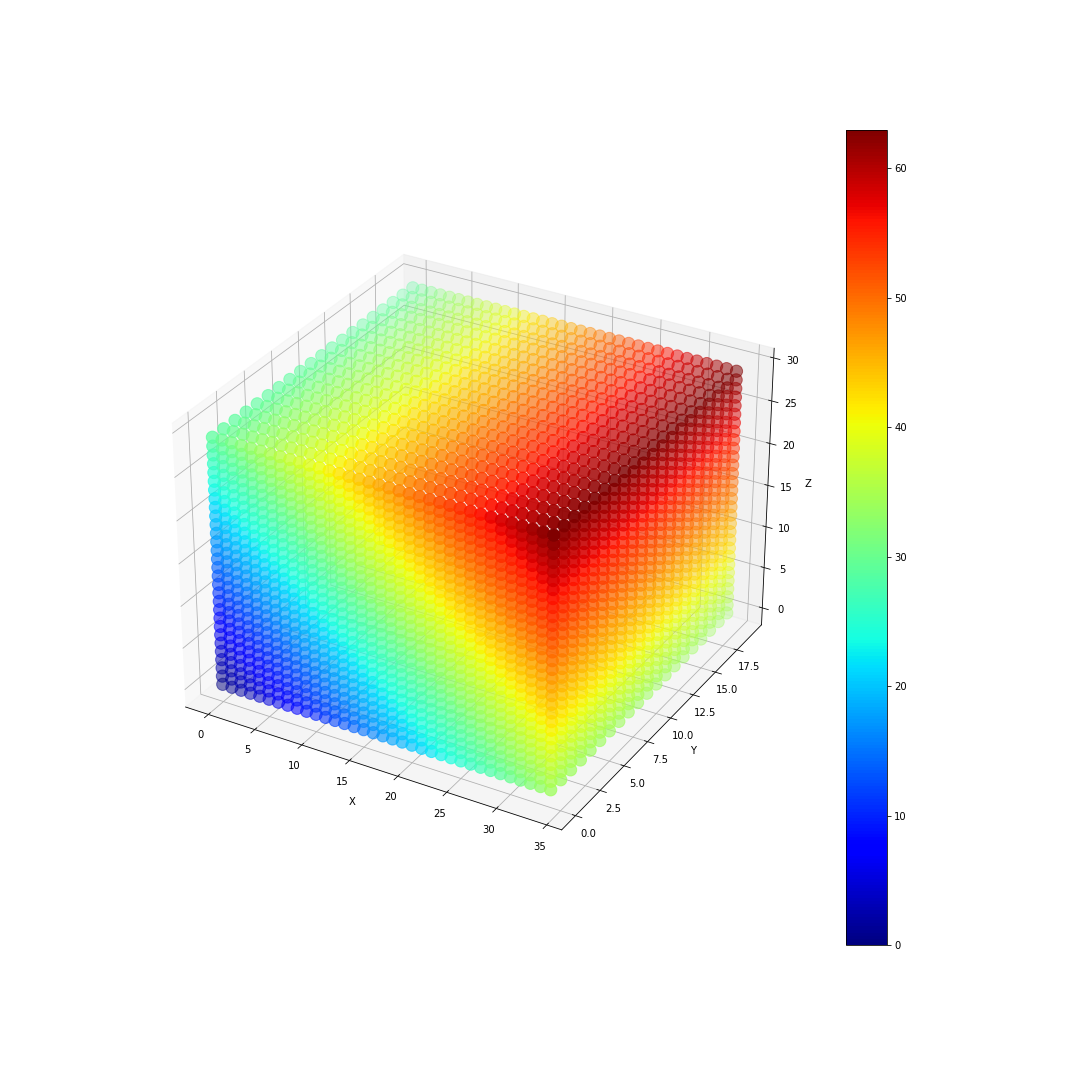I'm trying to use finite differences to solve the diffusion equation in 3D. I think I'm having problems with the main loop. In particular the discrete equation is:

With Neumann boundary conditions (in just one face as an example):

Now the code:
import numpy as np
from matplotlib import pyplot, cm
from mpl_toolkits.mplot3d import Axes3D ##library for 3d projection plots
%matplotlib inline
kx = 15 #Number of points
ky = 15
kz = 15
largx = 90 #Domain length.
largy = 90
largz = 90
dt4 = 1/2 #Time delta (arbitrary for the time).
dx4 = largx/(kx-1) #Position deltas.
dy4 = largy/(ky-1)
dz4 = largz/(kz-1)
Tin = 25 #Initial temperature
kapp = 0.23
Tamb3d = 150 #Ambient temperature
#Heat per unit of area. One for each face.
qq1=0 / (largx*largz)
qq2=0 / (largx*largz)
qq3=0 / (largz*largy)
qq4=0 / (largz*largy)
qq5=0 / (largx*largy)
qq6=1000 / (largx*largy)
x4 = np.linspace(0,largx,kx)
y4 = np.linspace(0,largy,ky)
z4 = np.linspace(0,largz,kz)
#Defining the function.
def diff3d(tt):
w2 = np.ones((kx,ky,kz))*Tin #Temperature array
wn2 = np.ones((kx,ky,kz))*Tin
for k in range(tt+2):
wn2 = w2.copy()
w2[1:-1,1:-1,1:-1] = (wn2[1:-1,1:-1,1:-1] +
kapp*dt4 / dy4**2 *
(wn2[1:-1, 2:,1:-1] - 2 * wn2[1:-1, 1:-1,1:-1] + wn2[1:-1, 0:-2,1:-1]) +
kapp*dt4 / dz4**2 *
(wn2[1:-1,1:-1,2:] - 2 * wn2[1:-1, 1:-1,1:-1] + wn2[1:-1, 1:-1,0:-2]) +
kapp*dt4 / dx4**2 *
(wn2[2:,1:-1,1:-1] - 2 * wn2[1:-1, 1:-1,1:-1] + wn2[0:-2, 1:-1,1:-1]))
#Neumann boundary (dx=dy=dz for the time)
w2[0,:,:] = w2[0,:,:] + 2*kapp* (dt4/(dx4**2)) * (w2[1,:,:] - w2[0,:,:] - qq1 * dx4/kapp)
w2[-1,:,:] = w2[-1,:,:] + 2* kapp*(dt4/(dx4**2)) * (w2[-2,:,:] - w2[-1,:,:] + qq2 * dx4/kapp)
w2[:,0,:] = w2[:,0,:] + 2*kapp* (dt4/(dx4**2)) * (w2[:,1,:] - w2[:,0,:] - qq3 * dx4/kapp)
w2[:,-1,:] = w2[:,-1,:] + 2*kapp* (dt4/(dx4**2)) * (w2[:,-2,:] - w2[:,-1,:] + qq4 * dx4/kapp)
w2[:,:,0] = w2[:,:,0] + 2 *kapp* (dt4/(dx4**2)) * (w2[:,:,-1] - w2[:,:,0] - qq5 * dx4/kapp)
w2[:,:,-1] = w2[:,:,-1] + 2 *kapp* (dt4/(dx4**2)) * (w2[:,:,-2] - w2[:,:,-1] + qq6 * dx4/kapp)
w2[1:,:-1,:-1] = np.nan #We'll only plot the "outside" points.
w2_uno = np.reshape(w2,-1)
#Plotting
fig = pyplot.figure()
X4, Y4, Z4 = np.meshgrid(x4, y4,z4)
ax = fig.add_subplot(111, projection='3d')
img = ax.scatter(X4, Y4, Z4, c=w2_uno, cmap=pyplot.jet())
fig.colorbar(img)
pyplot.show()
For 5000 iterations (qq6 = 1000/Area) we get:

I'm only applying heat on the top surface. Somehow I end up with the bottom surface heating up.
Adding to that I'm trying to confine the region to which I apply heat (just a small part of one face). When I try that it seems like heat is only transferred in one direction, ignoring all others. Applying (qq1 = 1000/Area) for half of the front face (the other part is adiabatic, q = 0) we end up with:

This is pretty odd. I suspect I'm having some trouble in the main loop (or maybe in the boundary conditions) that I'm not finding.


